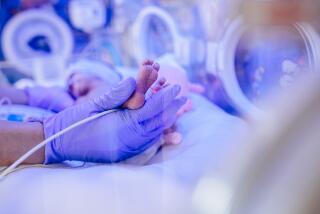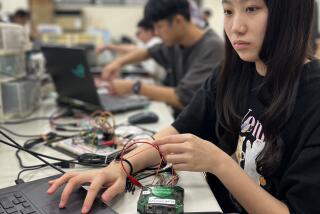Miscarriages--Reaction to Computer Chip Study Is Strong
An unpublished study suggesting that women who assemble computer chips have a high incidence of miscarriages is sending shock waves through the semiconductor industry and challenging its reputation as a clean industry that poses few health and safety problems for its workers.
But the report itself is less damning than the strong reaction might suggest, according to one of its principal authors, Edward J. Calabrese, a toxicologist at the University of Massachusetts School of Public Health in Amherst. âThis is not the definitive study,â he said.
The industry-sponsored report last week prompted the American Telephone & Telegraph Co. to âstrongly recommendâ transfers for all pregnant women employed on its computer chip production lines in Florida, Missouri and Pennsylvania and to guarantee them new jobs at comparable pay and benefits.
In California, major manufacturers in the so-called Silicon Valley on the lower part of the San Francisco Peninsula, such as Intel, Advanced Micro Devices and National Semiconductor Corp., have informed their employees of the study, but have not changed their policies for pregnant workers.
âThere just isnât enough information yet,â said Sheila Sandow, a spokeswoman for the Semiconductor Industry Assn., the industryâs Cupertino-based trade organization.
Policies of Silicon Valley companies often facilitate transfers of pregnant women from the so-called âclean roomsâ to other jobs, if recommended by a workerâs physician. But the policies do not require transfers or always guarantee job security. The majority of chip production workers are young women.
The study of the Digital Equipment Corp.âs plant in Hudson, Mass., which was completed last fall, is the first comprehensive look at the health of semiconductor production workers, many of whom are exposed to a variety of dangerous solvents, acids and gases.
The key conclusion--about a high rate of miscarriages--is based on a total of seven miscarriages in a group of 67 female production workers, compared to the three or four miscarriages that would have been expected by chance. These numbers may be too small to draw firm conclusions for the entire industry.
The industry responses are âclearly more conservative than our conclusions would necessarily warrant,â Calabrese said in a telephone interview. But he applauded semiconductor manufacturers for âerring on the side of safetyâ until larger and more comprehensive studies are completed to see if the findings apply to workers at other plants.
âReproductive success is a sensitive issue,â Calabrese said. âThe concern about job-related miscarriages is real but this is not the study that will end the debate.â
Digital commissioned the study by Calabrese and his colleague Harris Pastides, an epidemiologist, in 1984, after production workers at the Hudson plant, west of Boston, expressed alarm about what seemed to be a high number of miscarriages.
The study initially involved 300 workers but was expanded over a two-year period to 744 workers, more than 80% of those who had worked at the plant since it opened in 1980. The employees were asked to complete an extensive questionnaire covering all aspects of their health history.
To analyze the data, the workers were split into three groups, according to Calabrese.
One was a control group of employees not involved in chip manufacture. The 340 women in this group had a miscarriage rate of 18%, consistent with estimates that between 10% and 20% of all pregnancies in the United States result in miscarriages.
The second and third groups worked in the clean rooms. Those in the second group were primarily exposed to solvents. The 67 women in this group had a miscarriage rate of 29%, which represented five miscarriages out of 17 pregnancies. This was not a âstatistically significantâ difference from the control group, Calabrese said.
Workers in the third group were primarily exposed to acids and gases. The 67 women in this group had a 39% miscarriage rate, which represented seven miscarriages out of 18 pregnancies. There was less than a 5% likelihood that this high rate was due to chance or to other factors that contribute to miscarriages, such as the womenâs age or a history of miscarriages, Calabrese said.
Clean-room workers also reported higher rates of headaches, nausea, sore throats and rashes compared to the control group, according to Jeffry Gibson, a Digital spokesman.
But the men and women production workers studied were not at increased risk for other serious health problems, including cancer, birth defects and infertility.
After the University of Massachusetts researchers briefed Digital on their results in November, word of the study spread rapidly. But some criticized the industry response as inadequate.
âThe position AT & T has taken only goes half way,â said Ted Smith, executive director of the Silicon Valley Toxics Coalition, an activist community organization based in San Jose. âThe industry should remove the (dangerous) chemicals from the workplace, not the workers.â
As an example, Smith said the semiconductor manufacturers should find a replacement for the widely used and controversial glycol ether solvents. These chemicals, often marketed under the brand name Cellosolve, have been known since 1982 to cause birth defects and other reproductive problems in laboratory animals.
Conference Scheduled
Later this month, a team of occupational health experts from the Semiconductor Industry Assn. will meet with the University of Massachusetts researchers and then make recommendations about further actions, perhaps including an industrywide study of miscarriages and other medical issues.
In California, further studies may also involve the state Department of Health Services, which under a 1986 state law has the authority to enter the workplace and collect information.
âWe are interested in working with industry on a follow-up study or doing a follow-up study (on our own),â said Shanna Swan, chief of the departmentâs Berkeley-based health assessment and surveillance unit. âThe Digital study was careful and well done. (The results) are not a catastrophe but they should be taken very seriously.â






